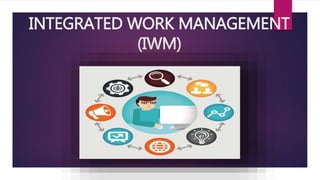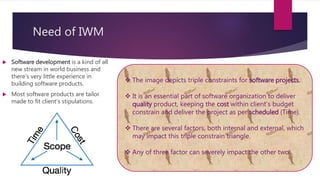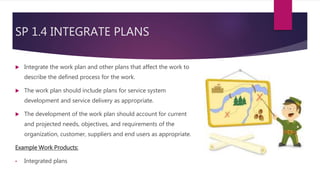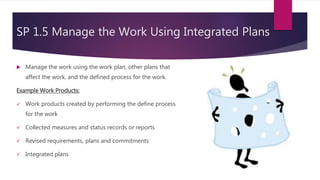Cmmi integrated work management level01
- 2. PURPOSE: The purpose of Integrated Work Management (IWM) is ŌĆ£establish and manage the work and the involvement of relevant stakeholders according to an integrated and defined process that is tailored from the organizationŌĆÖs set of standard processes (defined process for the work)ŌĆØ.
- 3. Need of IWM ’üĄ Software development is a kind of all new stream in world business and thereŌĆÖs very little experience in building software products. ’üĄ Most software products are tailor made to fit clientŌĆÖs stipulations. ’üČ The image depicts triple constraints for software projects. ’üČ It is an essential part of software organization to deliver quality product, keeping the cost within clientŌĆÖs budget constrain and deliver the project as per scheduled (Time). ’üČ There are several factors, both internal and external, which may impact this triple constrain triangle. ’üČ Any of three factor can severely impact the other two.
- 4. Defined process for the work: Ō£« Define processes needed to identify, define, combine, unify & coordinate the various processes and activities within the process groups. Ō£« Defining a simple and crystal clear process helps the organization to fruition the desired result with the fullest efficiency. The process area also addresses the coordination of activities such as: 1. Development activities (Requirements development design, verification)) 2. Service activities (delivery, help desk, customer contact) 3. Acquisition activities (Agreement monitoring, solicitation) 4. Support activities (training, marketing, documentation)
- 5. ’üĄ Establishing the defined process at work startup by tailoring the organizationŌĆÖs set of standard processes ’üĄ Managing the work using the defined process ’üĄ Establishing the work environment for the work based on the organizationŌĆÖs work environment standards ’üĄ Establishing teams that are tasked to accomplish work objectives ’üĄ Using and contributing to organizational process assets ’üĄ Enabling relevant stakeholdersŌĆÖ concerns to be identified, considered, and, when appropriate, addressed during the work Integrated Work Management involves the following activities:
- 6. Ensuring that relevant stakeholdersŌĆ”ŌĆ”. (1)Perform their tasks in a coordinated and timely manner to reduce the time consumption and increase the output (2)Address their requirements, plans, objectives, problems, and risks to improve the efficiency and ensure their smugness. (3)Fulfill their commitments and ensure they are self satisfied; and (4)Identify, track, and resolve coordination issues to reduce the risks.
- 7. How to manage the work effort, cost, schedule, staffing, risks and other factors? STAFFING Ōśø Managing People / Human resources Ōśø Act as leader Ōśø Liaison with stakeholders Ōśø Setting up reporting hierarchy etc. Ōśø Managing Projects efficiently Ōśø Defining and setting up project scope Ōśø Managing project management activities Ōśø Monitoring progress and performance Ōśø Risk analysis at every phase Ōśø Take necessary step to avoid or come out of problems Ōśø Act as project spokesperson Ōśø Delegation of authority RISK SCHEDULE Ōśø Breaking down the project tasks into smaller, manageable form Ōśø Finding out various tasks and correlate them Ōśø Estimating time frame required for each task Ōśø Dividing time into work-units Ōśø Assigning adequate number of work-units for each task Ōśø Calculating total time required for the project from start to finish MONITOR MANAGE CATEGORIZE IDENTIFICATION
- 8. TIME Ōśø Once size and efforts are estimated, the time required to produce the software can be estimated. Ōśø Efforts required is segregated into sub categories as per the requirement specifications and interdependency of various components of software. Ōśø The tasks can be scheduled on day-to- day basis or in calendar months. Ōśø The sum of time required to complete all tasks in hours or days is the total time invested to complete the project. COST For estimating project cost, it is required to consider, Ōśø Size of software Ōśø Software quality Ōśø Hardware Ōśø Additional software or tools, licenses etc. Ōśø Skilled personnel with task-specific skills Ōśø Travel involved Ōśø Communication Ōśø Training and support
- 9. SPECIFIC PRACTICES BY GOALS SG 1 Use Defined Process for the Work SG 2 Coordinate and Collaborate with Relevant stakeholders SP 1.1 Establish the defined process SP 2.1 Manage Stakeholder Involvement SP 1.2 Use Organizational process Assets for Planning Work Activities SP 2.2 Manage dependencies SP 1.3 Establish the Work Environment SP 2.3 Resolve coordination issues SP 1.4 Integrate Plans SP 1.5 Manage the Work Using Integrated Plans SP 1.6 Establish Teams SP 1.7 Contribute to Organizational Process Assets
- 10. SP 1.1 Establish the Defined Process for the Work Factors: ’üĄ Stakeholder requirements ’üĄ Commitments ’üĄ Organizational process needs and objectives ’üĄ The organizationŌĆÖs set of standard processes and tailoring guidelines ’üĄ The operational environment ’üĄ The business environment ’üĄ The service delivery environment ŌĆó Establish and maintain the defined process from startup and throughout the work. Example Work Products: 1. The defined process for the work.
- 11. 1. Select a lifecycle model from the ones available in organizational process assets. 2. Select standard processes from the organizationŌĆÖs set of standard processes that best fit the needs of the work. 3. Tailor the organizationŌĆÖs set of standard processes and other organizational process assets according to tailoring guidelines to produce the defined process for the work. 4. Use other artifacts from the organizationŌĆÖs process asset library as appropriate. 5. Document the defined process for the work. 6. Conduct peer reviews of the defined process for the work. 7. Revise the defined process for the work as necessary. SUB PRACTICES
- 12. SP 1.2 Use Organizational Process Assets for Planning Work Activities ’üĄ Use organizational process assets and the measurement repository for estimating and planning work activities ’üĄ When available, use results of previous planning and execution activities as predictors of the relative scope and risk of the effort being estimated. Example Work Products: 1. Work estimates 2. Work plans
- 13. 1. Use the tasks and work products of the defined process for the work as a basis for estimating and planning work activities. 2. Use the organizationŌĆÖs measurement repository in estimating the work planning parameters. SUB PRACTICES The estimate typically includes the following: ŌĆó Appropriate historical data from this work or similar work ŌĆó Similarities and differences between the current work and work from which historical data will be used ŌĆó Validated historical data ŌĆó Reasoning, assumptions and rationale used to select the historical data Examples of parameters Work product & task attributes Application domain Service system and itŌĆÖs components Operational or delivery environment Experience of the people
- 14. ExamplesofData EFFORT COST SCHEDULE STAFFING SIZE OF WORK PRODUCTS OR OTHER WORK PRODUCT ATTRIBUTES RESPONSE TIME SERVICE CAPACITY QUALITY SUPPLIER PERFORMANCE
- 15. SP 1.3 Establish the Work Environment ’üĄ An appropriate work environment for the work comprises an infrastructure of facilities, tools & equipment that people need to perform their jobs effectively in support of business and service objectives. Example Work Products: o Equipment and tools for the work o Installation, operation & maintenance manuals for the work environment o User surveys and results o Use, performance, and maintenance tools o Support services for the work environment
- 16. SUB PRACTICES 1. Plan, design & install a work environment 2. Provide ongoing maintenance & operational support for the work environment 3. Maintain the qualification of components of the work environment 4. Periodical review how well the work environment is meeting work activity needs & supporting collaboration, and take action as appropriate
- 17. SP 1.4 INTEGRATE PLANS ’üĄ Integrate the work plan and other plans that affect the work to describe the defined process for the work. ’üĄ The work plan should include plans for service system development and service delivery as appropriate. ’üĄ The development of the work plan should account for current and projected needs, objectives, and requirements of the organization, customer, suppliers and end users as appropriate. Example Work Products: ŌĆó Integrated plans
- 18. SUB PRACTICES Integrate other plans that affect the work with the work plan Incorporating the definitions of measures & measurement activities for managing the work Identify & analyze product and work group interface tasks Schedule tasks in a sequence that accounts for critical development, delivery factors & work risks Incorporate plans for performing peer reviews on work products Incorporate the training needed to perform the defined process into the training plans Establish objective entry and exit criteria to authorize the initiation & completion of tasks Ensuring the work plans compatibility with plans relevant to the stakeholders Identify how conflicts will be resolved that arise among relevant stakeholders
- 19. SP 1.5 Manage the Work Using Integrated Plans ’üĄ Manage the work using the work plan, other plans that affect the work, and the defined process for the work. Example Work Products: ’ā╝ Work products created by performing the define process for the work ’ā╝ Collected measures and status records or reports ’ā╝ Revised requirements, plans and commitments ’ā╝ Integrated plans
- 20. SUB PRACTICES 1. Implement the defined process using the organizationŌĆÖs process asset library 2. Monitor and control the work activities and work products using the defined process for the work, work plan & other plans that affect the work 3. Obtain & analyze selected measurements to manage the work and support organization needs 4. Periodically review and align the service performance with current and anticipated needs, objectives & requirements of the org., customer & end users as appropriate 5. Address causes of selected issues that can affect work objectives
- 21. SP 1.6 ESTABLISH TEAMS ’üĄ The work is managed using teams that reflect the organizational rules and guidelines for team structuring, formation and operation. ’üĄ One of the best ways to ensure coordination and collaboration with relevant stakeholders is to include them on the team. Example Work Products: ’ü▒ Documented shared vision ’ü▒ List of members assigned to each team ’ü▒ Team charters ’ü▒ Periodic team status reports
- 22. SUB PRACTICES Establish & maintain the work groupŌĆÖs shared mission Establish & maintain the team structure Establish & maintain each team Periodically evaluate the team structure and composition
- 23. SP 1.7 Contribute to Organizational Process Assets ’üĄ Contribute process related experiences to organizational process assets Example Work Products: 1. Proposed improvements to organizational process assets 2. Actual process and product measures collected from the work 3. Documentation (e.g., exemplary process descriptions, plans, training modules, checklists, lessons learned) 4. Process artifacts associated with tailoring and implementing the organizationŌĆÖs set of standard processes for the work.
- 24. 1. Propose improvements to the organizational process assets 2. Store process and product measures in the organization's measurement repository 3. Submit documentation for possible inclusion in the organization's process asset library 4. Document lessons learned from the work for inclusion in the organization's process asset library 5. Provide process artifacts associated with tailoring and implementing the organizationŌĆÖs set of standard processes in the support of the organizationŌĆÖs process monitoring activities SUB PRACTICES
- 25. SG 2 Coordinate and Collaborate with Relevant Stakeholders
- 26. SP 2.1 MANAGE STAKEHOLDER INVOLVEMENT ’üĄ Stakeholder involvement is managed according to the integrated plan and defined process for the work. Example Work Products: ŌĆó Agendas and schedules for collaborative activities ŌĆó Recommendations for resolving relevant stakeholder issues ŌĆó Documented issues (e.g., issues with stakeholder and services system requirements, architecture, design.
- 27. SUB PRACTICES: 1. Coordinate with relevant stakeholders who should participate in work activities. ŌĆó The relevant stakeholders should already be identified in the work plan. 2. Ensure Ensure work products that are produced to satisfy commitments meet the requirements of the recipients. ŌĆó The work products produced to satisfy commitments can be services. 3. Develop recommendations and coordinate actions to resolve misunderstandings and problems with requirements.
- 28. SP 2.2 MANAGE DEPENDENCIES ’üĄ Participate with relevant stakeholders to identify, negotiate and track critical dependencies. ’ü▒ Defects, issues and action items resulting from reviews with relevant stakeholders. ’ü▒ Critical dependencies ’ü▒ Commitments to address critical dependencies ’ü▒ Status of critical dependencies.
- 29. SUB PRACTICES: Conduct reviews with relevant stakeholders Review and get agreement on commitments to address each critical dependency with those who are responsible for providing or receiving work product or services Identify each critical dependency Document critical dependencies and commitments Establish need dates and plan dates for each critical dependency based on the work schedule Track the critical dependencies and commitments and take corrective actions as appropriate.
- 30. SP 2.1 Resolve Coordination Issues Example of Coordination issues: ’üČ Service system requirements and design defects ’üČ Late critical dependencies and commitments ’üČ Product level problems ’üČ Unavailable critical resources or staff Example Work Products 1. Relevant stakeholder coordination issues 2. Status of relevant stakeholder coordination issues
- 31. SUB PRACTICES: 1. Identify and document issues 4. Escalate to appropriate managers the issues not resolvable with relevant stakeholders 2. Communicate issues to relevant stakeholders 5. Track issues to closure 3. Resolve issues with relevant stakeholders 6. Communicate with relevant stakeholders on the status and resolution of issues.































